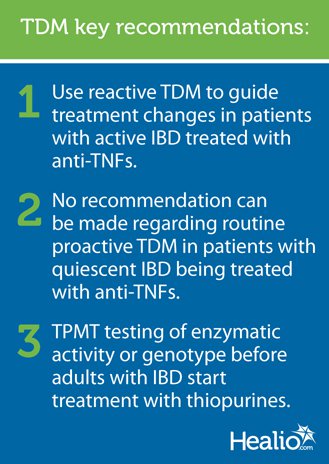AGA Releases Guideline on Therapeutic Drug Monitoring in IBD

The AGA has issued new guideline recommendations on therapeutic drug monitoring in patients with inflammatory bowel disease treated with anti-TNF agents and thiopurines.
The guideline also includes recommendations for thiopurine methyltransferase (TPMT) enzyme measurement or genotyping before starting a thiopurine, but does not address therapeutic drug monitoring in patients treated with Entyvio (vedolizumab, Takeda) or Stelara (ustekinumab, Janssen) due to a lack of available data.
“Therapeutic drug monitoring is a promising strategy to optimize IBD therapeutics. It is based on the premise that there is a relationship between drug exposure and outcomes, and that considerable inter-individual variability exists in how patients metabolize the drug (pharmacokinetics) and the magnitude and duration of response to therapy (pharmacodynamics),” Siddharth Singh, MD, MS, of the division of gastroenterology at University of California, San Diego, and the AGA Clinical Guidelines Committee, told Healio Gastroenterology and Liver Disease. “It is frequently used in the management of patients with IBD, especially with anti-TNF agents, but with considerable inter-provider variability. Hence, we developed these clinical guidelines to inform different strategies of applying [therapeutic drug monitoring (TDM)] in IBD.”
Reactive TDM to guide treatment
According to Singh, the guideline includes three key recommendations. The first is a conditional recommendation suggesting the use of reactive TDM to guide treatment changes in patients with active IBD treated with anti-TNFs.

“For patients on maintenance therapy with infliximab, adalimumab or certolizumab pegol who flare after initially responding, if trough levels are below 5 µg/mL, 7.5 µg/mL or 20 µg/mL, respectively without anti-drug antibodies or with low-titer antibodies, then it may be reasonable to try optimizing the index therapy (escalating anti-TNF agent by increasing dose, shortening interval and/or adding immunomodulator),” Singh said. “If on the other hand, drug is undetectable with high-titer anti-drug antibodies, then switching within class to another anti-TNF agent would be reasonable. Unfortunately, there are no defined cut-offs for low- or high-titer anti-drug antibodies, and these decisions require careful consideration.”
Proactive TDM benefits unclear
Second, the guideline states that no recommendation can be made regarding routine proactive TDM in patients with quiescent IBD being treated with anti-TNFs, as this is a critical knowledge gap in need of further study.
“At this time, the relative benefit vis-à-vis harms of this intervention is uncertain,” Singh said.
According to the guideline, while the benefit of proactive TDM in quiescent IBD is “biologically conceivable (presence of exposure-response relationship between trough concentration and clinical and endoscopic response, inter-individual variability in pharmacokinetics, especially the negative impact of anti-drug antibodies on drug clearance and efficacy), there is concern for harm especially due to premature switching away from index therapy (due to limited understanding of significance of low-titer anti-drug antibodies, resulting in inconsistent interpretation of anti-drug antibody titers and trough concentrations).”
Therefore, careful and selective use of proactive TDM could be beneficial, but current evidence for its routine use is limited and its overall benefits remain uncertain, Singh and colleagues wrote.
TPMT testing
Finally, the guideline suggests TPMT testing of enzymatic activity or genotype before adults with IBD start treatment with thiopurines.
While this strategy may not have significant benefits over population-level empiric weight-based dosing, the latter strategy may put a small subset of patients homozygous for TPMT at risk for severe neutropenia and infections, according to the guideline.
“However, this does not replace the need for ongoing laboratory monitoring for complete blood count and liver enzymes,” Singh noted.
The AGA has also provided a clinical decision support tool to help providers implement these recommendations in practice, and identified several knowledge gaps in an accompanying technical review. – by Adam Leitenberger
Disclosures: The researchers report no relevant financial disclosures.

